What to See in Bologna in One Day | Itinerary, Map and Tips

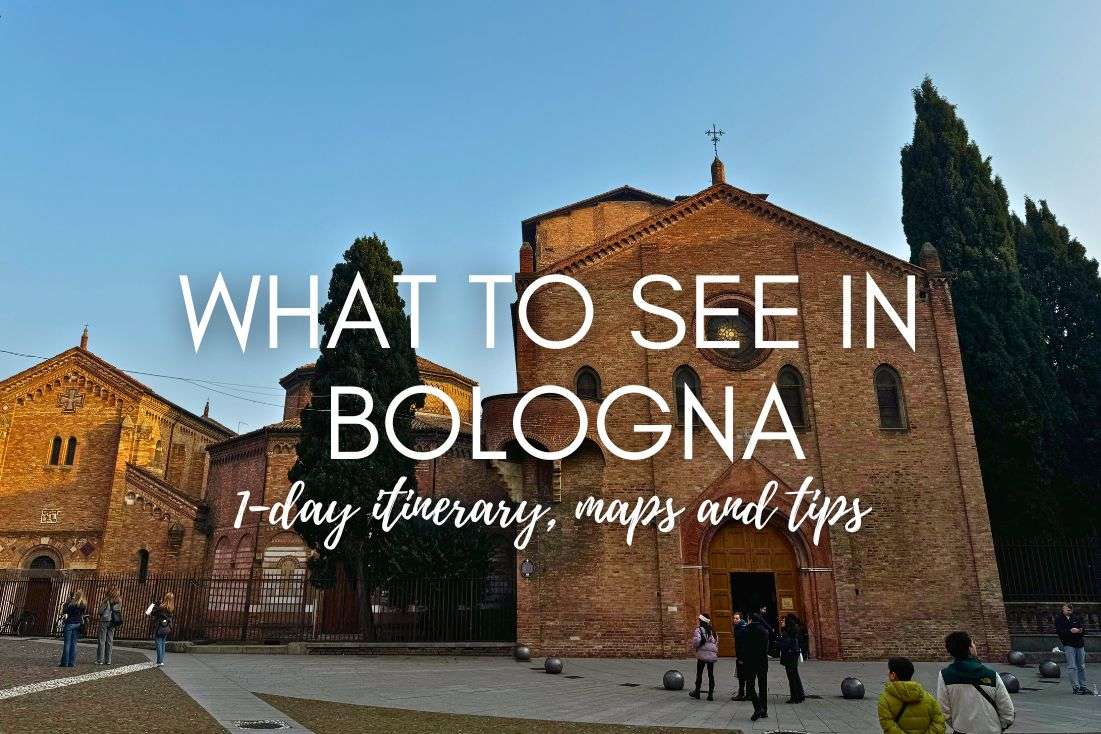
Thinking about visiting Bologna, Italy but only have a day to spare? Don’t worry—I’ve got you covered with what to see in Bologna, and how to squeeze every last drop of carbs and culture out of this lesser-visited Italian city. Your waistband might not thank you, but your soul certainly will!
Learn more about Italy right here...
Fun fact: Bologna is home to the world’s oldest university, and it’s absolutely teeming with students. Trust me—the swarms of big kids will be one of the first things you’ll notice.
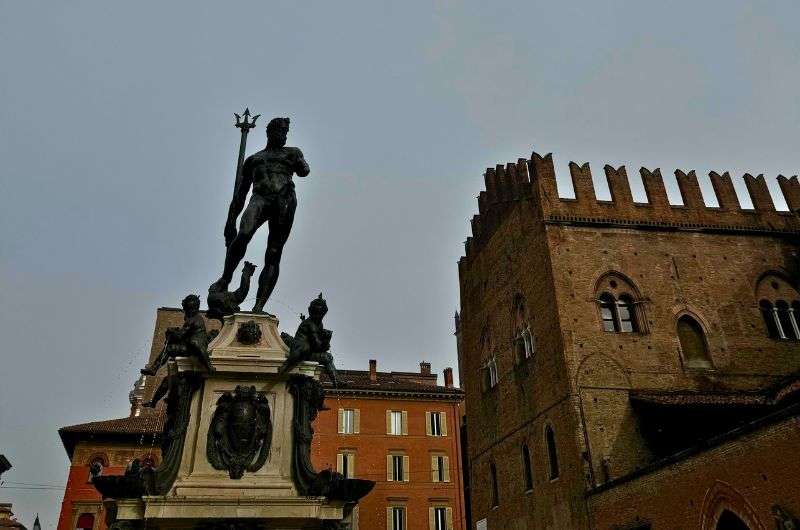
Statue of Neptune in Bologna
And if you have less than 24 hours, you’ll want a game plan to tackle the very best things to do in Bologna. And have I ever let you down? Of course, I haven’t! This itinerary is pulled straight from my recent trip to Northern Italy with my girlfriend. Oh, and it comes with a walking route and a map of Bologna—it’s all you’ll need!
Visit Bologna in one day: my itinerary
- Stop 1: Portico of San Luca—the longest covered walkway in the world, with (allegedly) 666 arches
- Stop 2: Madonna di San Luca—the basilica at the end of the Portico
- Stop 3: Piazza Maggiore—the heart of Bologna surrounded by mighty buildings, and a good place for people-watching
- Stop 4: Basilica di San Petronio—the half-finished, sixth-largest church in the world
- Stop 5: Two Towers—not as big as the Twin Towers, but still might collapse
- Stop 6: Sfoglia Rina—the best pasta lunch I’ve probably ever had
- Stop 7: Anatomical Theater of the Archiginnasio—where dead bodies were dissected (for educational purposes, of course)
- Stop 8: Museum of Palazzo Poggi—more creepy biology you didn’t learn at school
- Stop 9: Pinacoteca Nazionale di Bologna (National Art Gallery of Bologna)—a proper journey through the history of Italian art
- Stop 10: Basilica di Santo Stefano—a pint-sized, four-churched medieval gem
Sometimes, all you need to do is take the first step... I've filtered out the best hotels in Italy for you
Save it for yourself to come back to later, or share with your friends on social media!
I've already planned your ititnerary for the trip, complete with my travel tips.
We indulged in cheesy pasta, stomped over thousands of cobbles, and got lost in mazes of medieval porticoes... as well as church cloisters. Take it from me—Bologna sure is a city that knows how to make an impression on your taste buds, your camera roll, and your thighs.
So, slip into some comfy shoes and stretchy pants, and let’s explore Bologna in one day. I promise it’s going to be worth every step—and every calorie.
But before you make any trip to Italy, be sure to check out my article on these top 10 Italian travel tips:

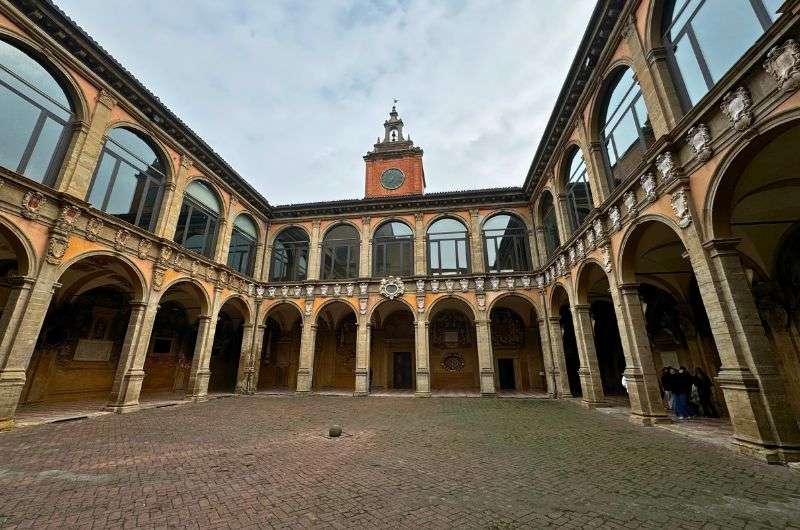
Archiginnasio Palace
Bologna in one day: bonus travel tips
- Bologna is very walkable, but if you want to go full local and zip around on a Vespa scooter, there are several rental providers both around the city and online. travelhoo.it is particularly highly rated.
- When outside the city center, I recommend using the EasyPark app. It’s super useful for finding and paying for parking.
- Italians are surprisingly polite drivers these days. It must be a generational thing...
- In restaurants, you can’t get away without paying a small coperto (“cover charge”—essentially a cost for the table). BUT you might be able to cheapen it by refusing the bread that the waiter will bring to you.
- Never order a cappuccino with a meal. They’re strictly for mornings—that’s the Italian way, no arguments.
- Eat spaghetti/tagliatelle/any other long pasta with a fork only. On an Italian table, the spoon is for soup.
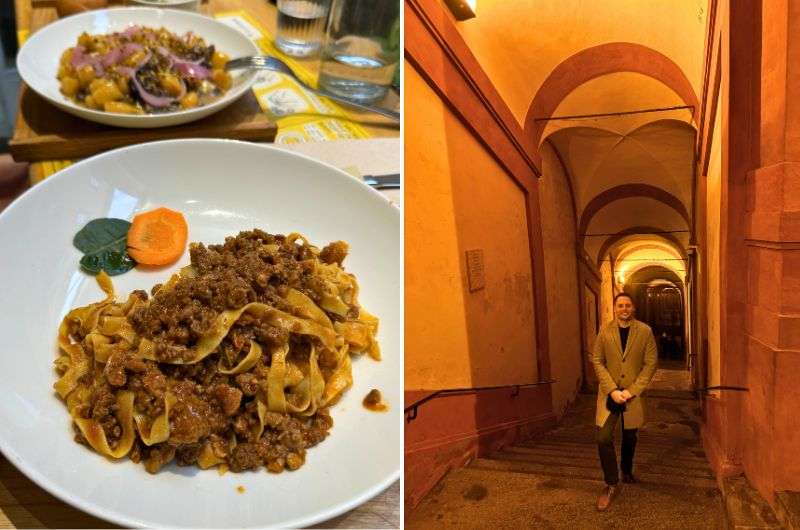
Remember, spaghetti only with a fork!
- Scarpetta is the art of mopping up the sauce from your plate with a piece of bread. In this part of the world, it’s not only accepted; it’s mandatory.
- Tipping isn’t technically obligatory, but it’s a thing. Don’t be cheap.
- November is a good time to visit Bologna (and Emilia-Romagna in general) because it’s the season for mushroom foraging and truffle fairs.
- If you feel you have too much time to spend in Bologna, day trips to Modena and Parma are definitely worth doing. For more inspiration, check out my articles on things to do in Parma and things to do in Modena.
- Finally, my hotel recommendation is RMH Modena Raffaello. It's a new-ish place (certainly very “Moden”!) with free parking, massive rooms, and even a pillow menu for picky sleepers. It's located right off the highway that connects Bologna and Modena, so it’s perfect for road trips.
Map of Bologna city center
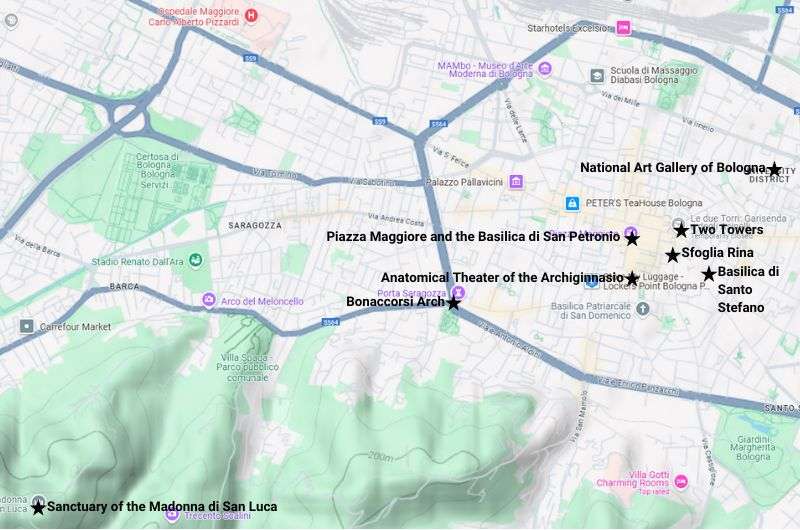
Map of Bologna city center, pinpointing the best things to do (Google Maps link to itinerary walking route)
Stop 1: Portico of San Luca
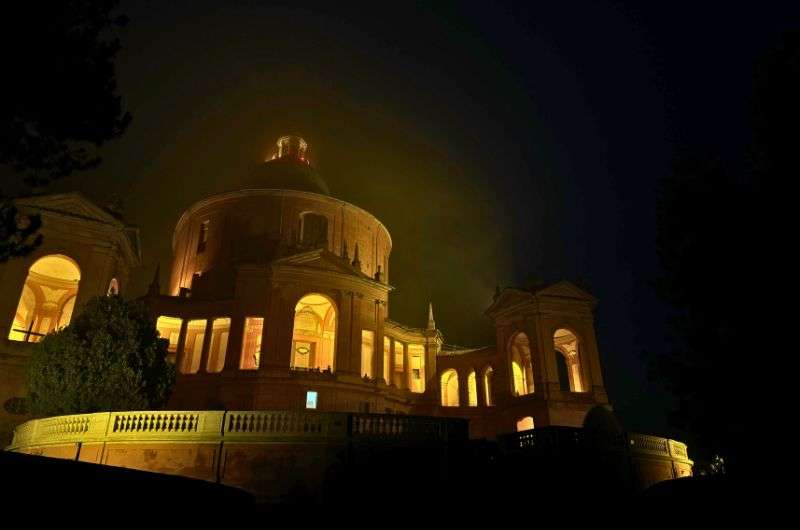
Basilica di San Luca
- Distance from hotel: 50 km (31 mi)
- Time spent here: 30 minutes–2.5 hours
If there’s one thing you’ll never forget about Bologna, it’s the porticoes (no other city on earth has as many as Bologna—fun fact!).
But this one is particularly insane—a crazy 3.5 km (2.2 mi) of covered walkway. Yes, you read that right—it’s a portico that long, snaking its way up a hill to the Sanctuary of the Madonna di San Luca, sitting pretty atop Monte della Guardia.
At first, the sheer length of the portico is laughable. Driving past it, we thought, “Seriously? More arches?!” But five minutes in, the absurdity gave way to awe.
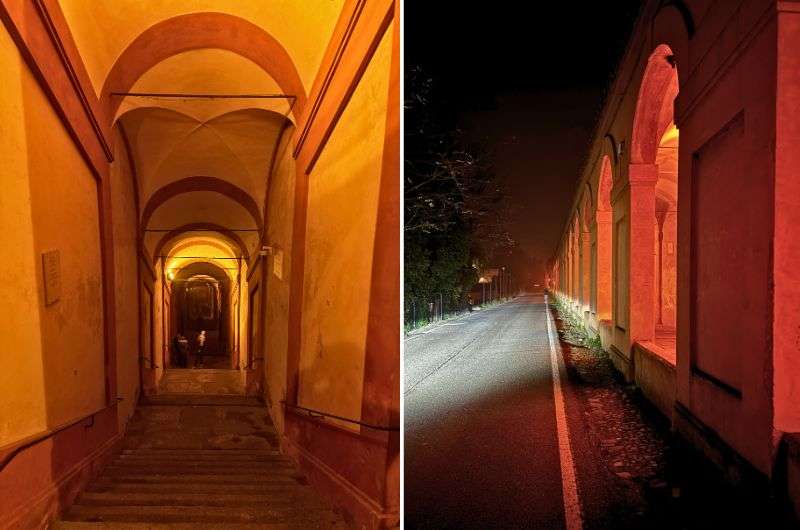
All the arches!
Where did this crazy idea come from?
Someone (actually, a lot of someone) built this massive structure starting in 1674 and finishing almost a century later. Why? To allow religious processions to carry the sacred image of the Madonna di San Luca down to the city without rain, snow, or the occasional pigeon ruining the vibe.
The portico’s 666 arches (or so they say—apparently, it depends on who’s counting) make it the longest covered walkway in the world, earning UNESCO World Heritage status in 2021. But don’t let its spooky number fool you—it’s less devilish, more divine.
Where to start the Portico of San Luca walk
If you’re feeling ambitious, by all means, walk the full route (spoiler: we were not feeling ambitious). It starts at Bonaccorsi Arch on Via Saragozza, and it’s flat for the first 1.5 km (0.93 mi).
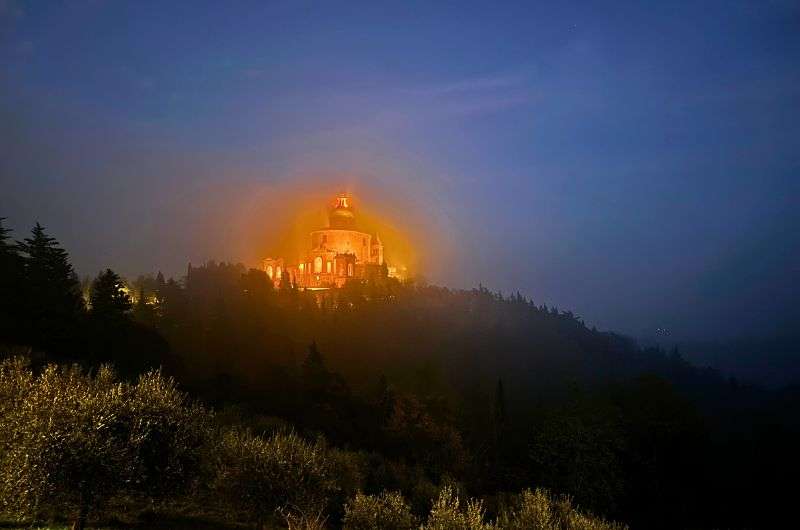
Reaching the sanctuary requires some effort
Then comes the uphill grind—a testing mix of inclines and steps. By the time you reach the sanctuary, you’ll probably either feel like a pious pilgrim or a sweaty draft horse—possibly both. At a consistent pace, the walk should take you around 1 hour each way.
What we did: Drove all the way up and parked just 300 m (0.19 mi) from the basilica. I mean, we had an itinerary to keep to...!
At the top of Monte della Guardia
It's a good job we didn’t trek up because just being at the Sanctuary is breathtaking enough. Its majestic dome towers over Bologna like a proud mother, and you get some seriously cool panoramic views.
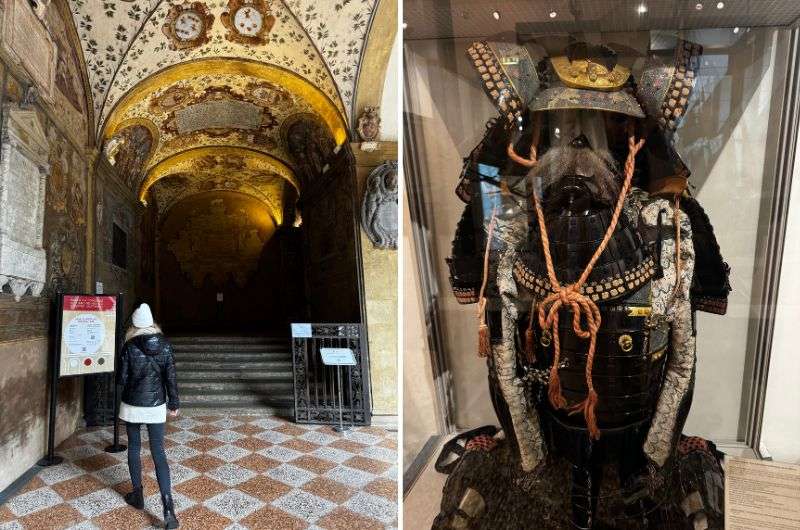
Exemplars in the museum
Inside, there’s the famous icon of the Virgin Mary, which legend claims was painted by St. Luke himself and carried all the way from Constantinople. If you think you did well with all those steps, just take a moment to think of this legend!
Pro tip: If you have time, visit the basilica at night as well. We did, and honestly, when it was lit up and surrounded by fog, it felt like we'd stumbled into a Gothic fairy tale.
Stop 2: Piazza Maggiore
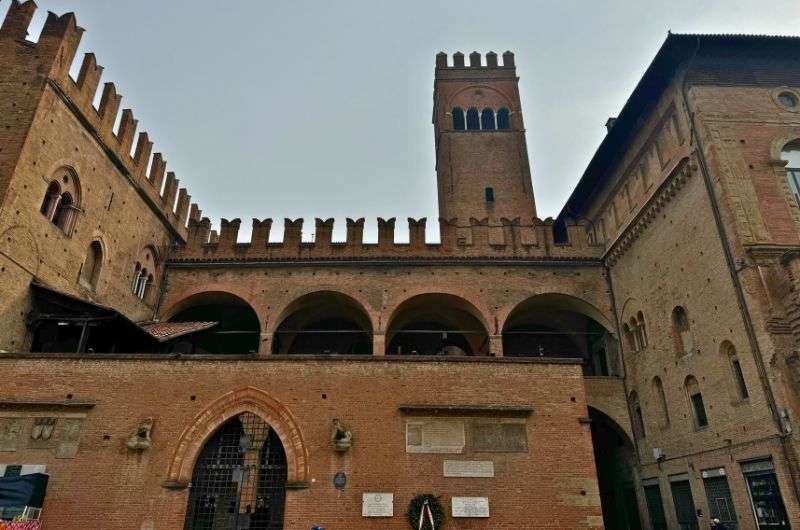
Piazza Maggiore
- Distance from last stop: 5 km (3.1 mi)
- Time spent here: 30 minutes
Back down in the historic city center, and if Bologna had a soul, this would be it. The Piazza Maggiore is a sprawling Renaissance square and the city’s beating heart, where locals and tourists mingle over coffee, gelato, and their shared love of people-watching.
Tip: This is also Bologna’s best starting point (think of the Portico of San Luca as the pilot in this Bologna in One Day series). Nearly all the major sights are within easy, direct distance from here—kind of like spokes on a wheel.
The grandest, show-stealing buildings of Bologna
The Piazza Maggiore is the kind of place that seems to bring history to life; it’s surrounded by an impressive cluster of medieval and Renaissance-era buildings. Dominating the northern edge is the Palazzo d'Accursio, which once served as Bologna’s city hall and now houses an art museum. It’s not the prettiest thing I’ve ever seen, to be honest.
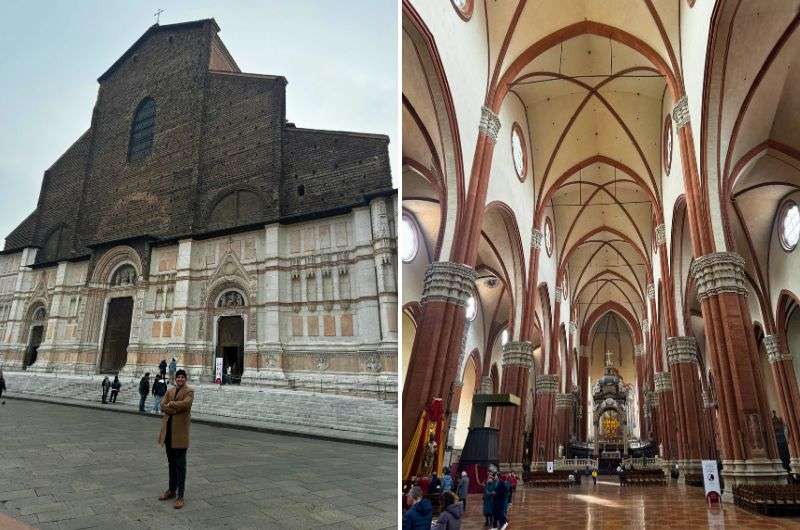
Basilica di San Petronio
On the eastern side, there’s the Palazzo del Podestà, a former seat of government that was once all about law and order.
But the true showstopper of the Piazza Maggiore is the Basilica di San Petronio, which looms at the southern edge of the square. It’s impossible to miss, and even harder not to gawk at. This is the next on this Bologna itinerary, so you'll learn more about it in a minute, but here's a teaser: it’s a towering Gothic giant that makes you feel like it’s going to scoop you up and swallow you whole.
Neptune’s Fountain
Right now, I have to mention Neptune’s Fountain (Fontana del Nettuno), which sits smack in the middle of the square. Yes, it’s a fountain, but don’t roll your eyes just yet! This quirky bronze statue of Neptune, perched atop a bubbling fountain and surrounded by mermaid-like figures, is an icon of the city. As such, you’ll find it near the top of just about any list of what to see in Bologna.
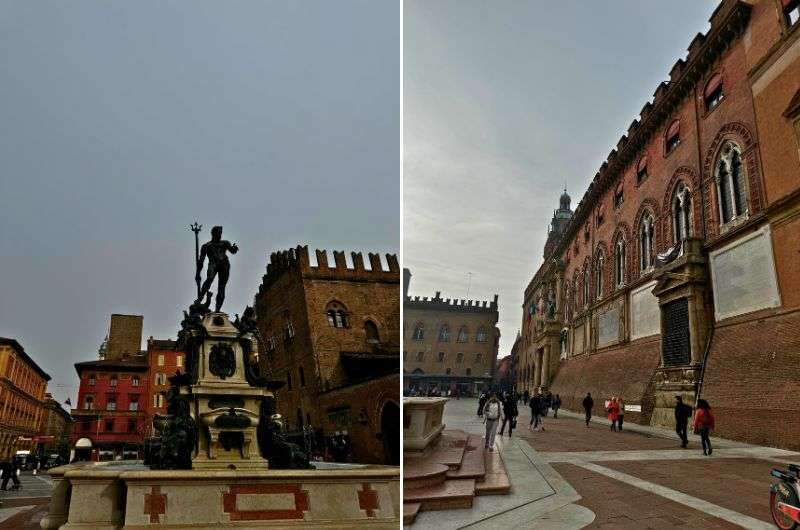
Neptune Fountain
For me, the real magic was the view of San Petronio rising behind it. You might come for the Neptune statue (okay, maybe not), but you’ll definitely stay to take such a postcard-perfect photo.
Another tip: Piazza Maggiore has a certain buzz at any time of day, but it really comes alive in the evening, so again, come back later if you’ve got time. The lights of the surrounding buildings, the chatter of locals enjoying aperitivo, and the glow of San Petronio make it feel like a movie set.
Right, are you ready for San Petronio...?
Stop 3: Basilica di San Petronio
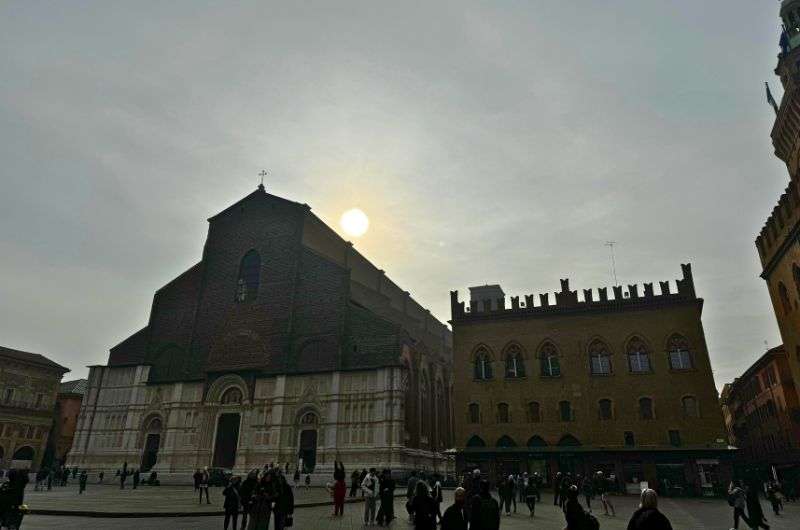
Basilica di San Petronio is not to be overlooked
- Distance from last stop: 70 m (76 yd)
- Time spent here: 30 minutes
- Opening hours: 8:30 am–1 pm and 2:30 pm–6 pm daily
- Price: free
When it comes to the question of what to see in Bologna, this stop isn’t exactly a matter of choice. You will see this absolute unit, whether you like it or not.
This is no ordinary church; this is a Gothic monster. At 132 m (433 ft) long and 47 m (154 ft) high, the Basilica di San Petronio is the sixth-largest church in the world and the largest Gothic one still in its original state. It’s so massive, it can fit 28,000 people—yep, that’s a stadium-level capacity for Sunday mass. Good luck finding a pew if you come at Easter.
It’s ugly, but you can’t take your eyes off it
The first thing I (and likely anyone who’s ever been here) noticed about San Petronio is its imperfect facade. The bottom half is a marble-clad masterpiece, while the top half is just very ugly brick. They never got around to finishing it—peak Italy. Why complete something when you can leave it “under construction” for a few hundred years and say it’s character?
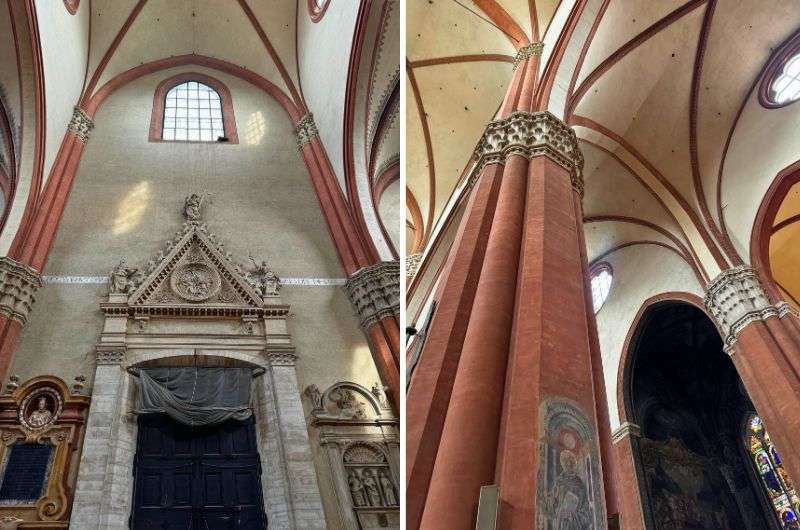
The Gothic interior of Basilica di San Petronio
Inside the Basilica is where things get interesting. The mix of Gothic and Baroque styles made my head spin, but it’s all part of the charm, so I told myself. The heights of the ceilings in a structure this old are difficult to comprehend. It’s all pretty overwhelming—you’ll have a hard time capturing the place in a single photo. (Believe me, I tried. And failed. Repeatedly.)
San Petronio’s best bits
Perhaps the basilica’s coolest feature is the meridian line, a 17th-century astronomical tool, running across its floor. The sun’s light hits the line at different points depending on the time of year, so you can basically tell time with a church floor. Who needs an Apple Watch anyway?
Another fun thing: If you’re an architecture nerd, look out for the unfinished plans to make San Petronio even bigger than St. Peter’s Basilica in Vatican City. Basically, the Pope wasn’t a fan of Bologna flexing on Rome, so he put a stop to the idea.
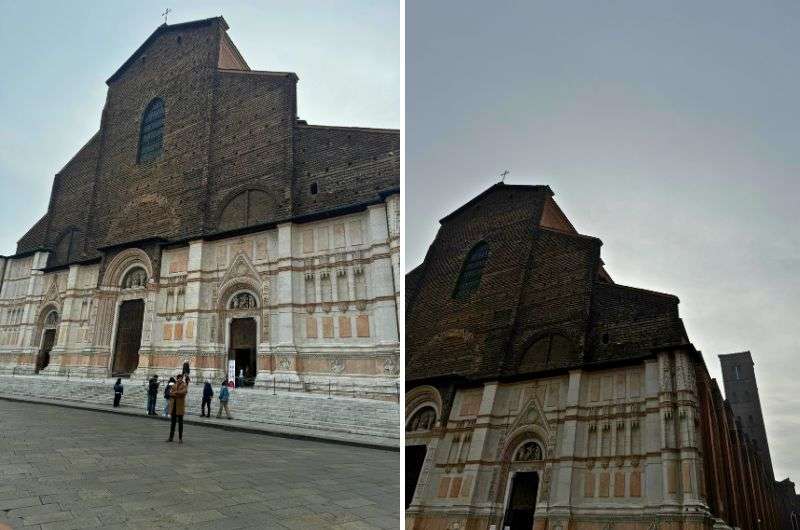
You can get to Basilica di San Petronio for free!
The entrance to this monumental basilica is completely free. That’s right—you can stroll into one of the largest Gothic churches on earth without spending a single euro! To be brutally honest, I wouldn’t charge people to come into my establishment either if it looked like that on the outside.
Important tip: Like in other Italian churches, there’s a dress code here: covered shoulders and pants, or at least knee-length shorts and skirts. If you’re a vest-and-hotpants-type tourist, they won’t let you in.
And when you’ve had your fill of Gothic glory, step back outside to Piazza Maggiore, and prepare for a medieval skyscraper moment.
Stop 4: Two Towers
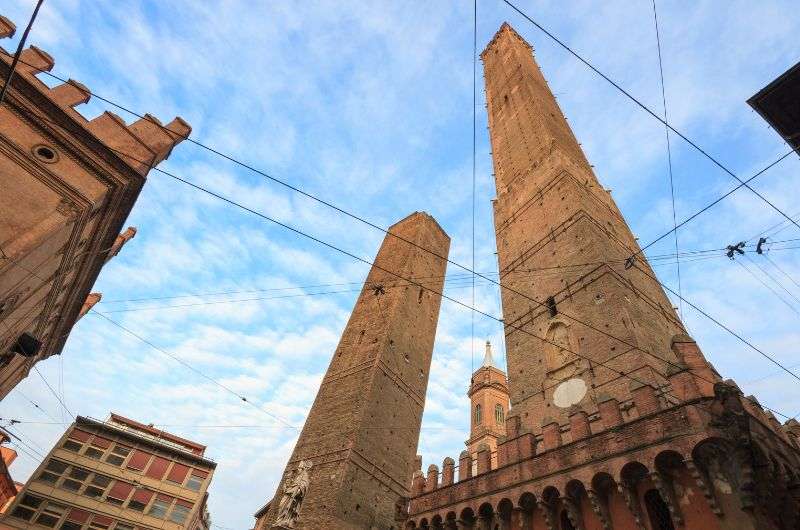
The Two Towers of Bologna
- Distance from last stop: 400 m (0.2 mi)
- Time spent here: 15 minutes
Take just a five-minute walk around the corner, and you’ll soon spot the Two Towers (Due Torri). These leaning medieval structures, Torre degli Asinelli (97 m [318 ft]) and Torre Garisenda (48 m [157 ft]) are iconically Bolognese and a 12th-century power flex.
Built-in 1119, these weren’t just watchtowers; they were status symbols for Bologna’s wealthy families, who clearly had some trust issues with their neighbors. I mean, imagine putting up a 30-story tower just to say, “Don’t even think about stealing my sheep.” Passive aggression on steroids.
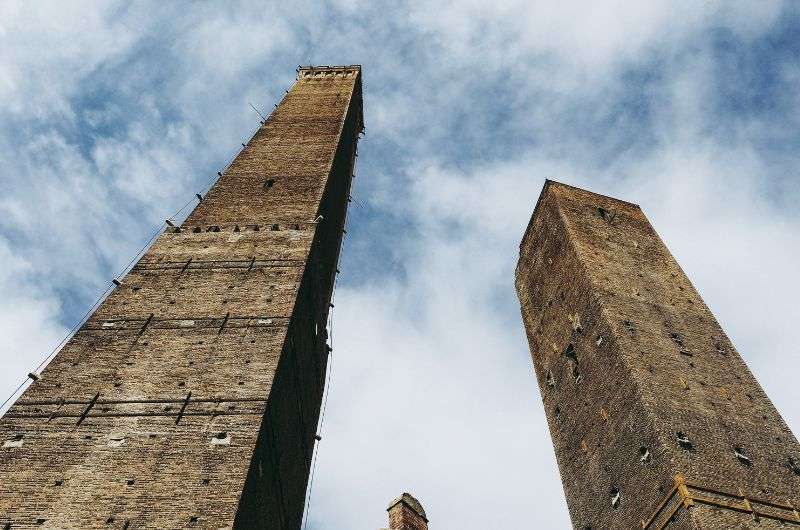
Torre degli Asinelli (on the left) and Torre Garisenda (on the right)
Come and see them, while you still can...!
Today, the Asinelli Tower remains the tallest leaning tower in Italy. It used to be open to climb, but since some worrying movement was detected in the Garisenda Tower’s slant in 2023, both structures are now closed, and a barrier has been put up around them in the event of any collapse.
For the residents, I guess it must feel like waiting for a volcano to erupt... only not quite as scary. Me? I just had the Lord of the Rings theme tune in my head the whole time.
Fun fact: Dante name-dropped these towers in The Divine Comedy. If they’re good enough for him, they’re good enough for your Bologna itinerary!
But staring at loads of old buildings is hungry work. Now it’s lunchtime, and we stumbled upon just the place...
Stop 5: Sfoglia Rina (for lunch)

The best place to have pasta Bolognese in Bologna
- Distance from last stop: 140 m (153 yd)
- Time spent here: 1.5 hours
- Opening hours: 9 am–9 pm (kitchen 11:30–8 pm) daily
No trip to Bologna (or Italy in general) is complete without indulging in some top-notch pasta, and Sfoglia Rina is the place to do it. Since 1967, this cozy, unpretentious spot has been serving up fresh pasta dishes that will ruin all other pasta for you. You have been warned.
First things first: This place is really popular, so don’t expect to waltz in and grab a table immediately. We had to wait a little while, but it was worth it. The restaurant buzzes with energy, and while it’s busy, the vibe is welcoming and laid-back. We didn't feel rushed, and the noise level stayed comfortably low. So far, so good.
You’ve never had pasta Bolognese like this before

Pasta Bolognese
Now, the food! We ordered the rabbit tortelli (an Emilia-Romagna specialty) and the tagliatelle with ragout (what we know as Bolognese sauce). The pasta was impeccably fresh, the filling and sauce bursting with flavor, and everything was cooked to perfection.
Our waiter (I didn’t get his name) was friendly, he delivered the food promptly, and he even threw in some interesting info-tidbits about where the ingredients came from. Pro-level service, right there.
Bonus: Unlike many Italian restaurants, Sfoglia Rina includes the service charge (coperto) in their prices. So, no surprise fees—just pure, carb-filled joy.
Stop 6: Anatomical Theater of the Archiginnasio
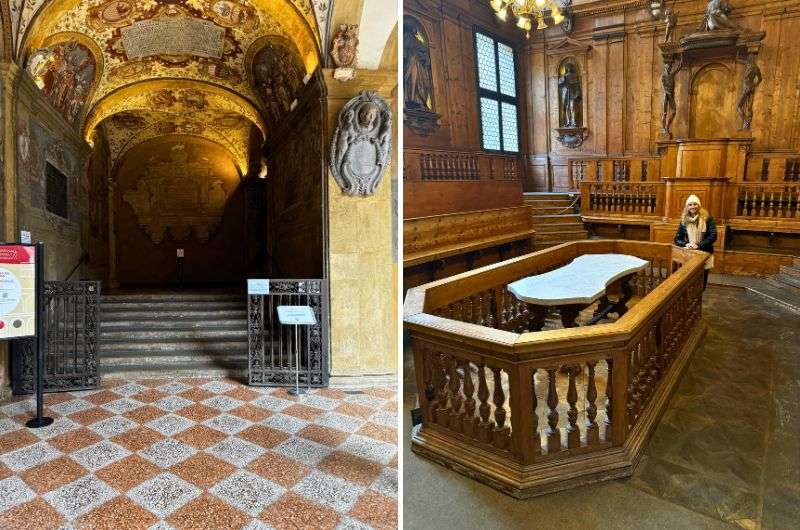
Theater time... sort of
- Distance from last stop: 500 m (0.3 mi)
- Time spent here: 30 minutes
- Opening hours: 10 am–6 pm Monday–Saturday
- Price: EUR 3 (+ EUR 0.50 for booking online)
If you’re the kind of traveler who loves a touch of the eerie with your intellectual history, the Anatomical Theater of the Archiginnasio is going to blow your mind.
This small, wood-paneled room was the epicenter of medical education in the 16th century. It’s here, beneath the carved wooden statues and under the gaze of skinless human figures holding their own muscles, that future doctors learned about the human body... by dissecting real cadavers. Creepy? Yep. Groundbreaking? Absolutely.
Gorgeous but nightmarish
Built in 1637, the theater was used for anatomy lessons at the University of Bologna (which, by the way, is the oldest university in the world—fun fact). And honestly, the room itself is nothing short of a work of art.
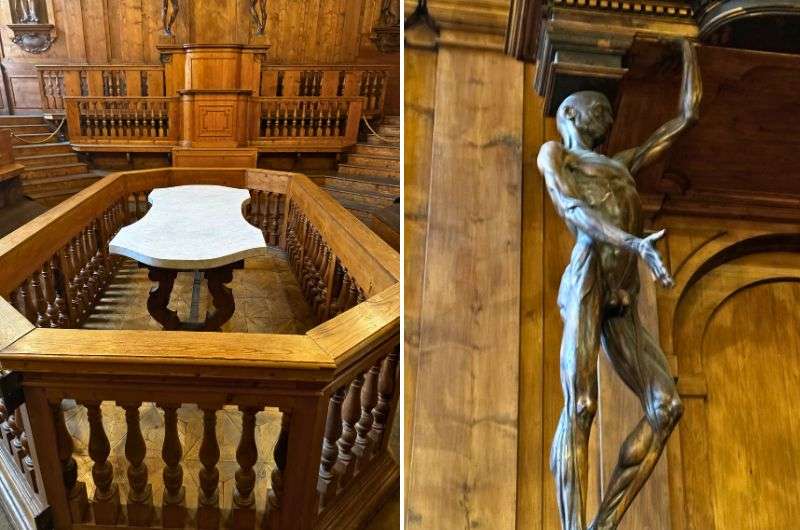
Spellati (“Skinned Men”) statue on the right
The walls and ceiling are covered in intricate carvings of mythological figures and famous physicians. I thought this was clever—I got the sense that they were trying to say they considered science (and medicine in particular) an art form. The centerpiece of the room is a marble dissection table—the silent and sturdy witness to centuries of discovery.
One of the most striking things about the theater—which I’ve just briefly mentioned—is the Spellati (“Skinned Men”) statues. These disturbingly detailed figures illustrate the musculature of the human body and were designed to help students better understand anatomy. Let’s just say they’re the original body horror, long before Hollywood got in the game.
Other odd things about this place
For some reason, they strongly advise you to get a ticket online in advance. It’s even mandatory for larger group visits and for everyone on Saturdays. You can do this at ticket.midaticket.it/teatroanatomicobologna/.
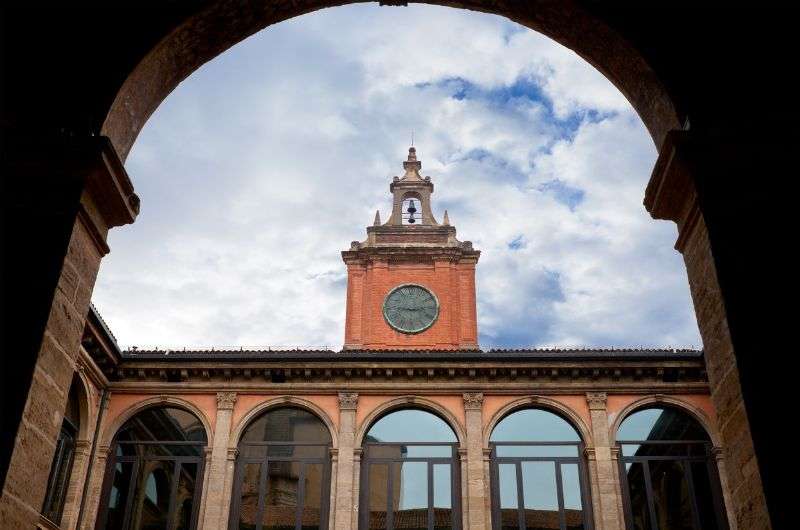
Archiginnasio Palace
Practical information: The Anatomical Theater is located inside the Archiginnasio Palace, a building that once served as the central hub of the university. Admission is included with a small ticket that also grants access to the Stabat Mater Hall (when it’s not in use). It's a weird room, all decorated with award plaques. But they’re obviously proud of it.
The theater isn’t very big, so you won’t need more than 30 minutes to take it all in. To sum up, it’s equal parts macabre and educational, offering a glimpse into the gritty realities of early medical science. It’s a far cry from today’s sterile lecture halls, and I think that's what made it so compelling to me!
Stop 7: Museum of Palazzo Poggi
- Distance from last stop: 1.2 km (0.7 mi)
- Time spent here: 1 hour
- Opening hours: 10 am–4 pm Tuesday–Friday; 10 am–6 pm Saturday–Sunday;
- Price: EUR 7
The Museo di Palazzo Poggi is also hidden inside the university. As a tourist, one minute, you’re dodging stressed-out students, and the next, you’re in a 17th-century museum filled with anatomical oddities, military strategy, and exploration history. It’s weird, fascinating, and slightly disturbing. Of course, we had to check it out.
Tip: Plan to spend about an hour here, though if you’re into anatomy or creepy historical science, you might want to linger.
A crazy mix of exhibits
The museum kicks off with geography and exploration—always my favorite sections! Expect old maps, navigation tools, and some bizarre attempts at preserving wildlife through paintings (because, you know, cameras weren’t a thing yet). A lot of the collection comes from Ulisse Aldrovandi, a Renaissance naturalist who was the David Attenborough of the time.
But let’s talk about the real highlight: the anatomy section. This is where things got… intense. The exhibit includes incredibly detailed models of fetuses in the womb, human skeletons, exposed muscles, and a disturbing number of deformities. It was unsettling, to say the least; absolutely not kid-friendly (FYI).
Disturbed enough? Here, military stuff will calm you down!
Another cool section covers military strategy and fortifications. Back in the day, building a fortress wasn’t just about stacking some bricks and calling it a day—without aerial views or Google Earth, designing defensive structures was an art. The museum has intricate models and manuals on fortress construction, which made me appreciate just how complex medieval warfare really was.
Overall, this place is a strange but fascinating detour, especially if you like science, history, and a little bit of weirdness. It’s definitely one of the most unique museums in Bologna.
Stop 8: Pinacoteca Nazionale di Bologna (National Art Gallery of Bologna)
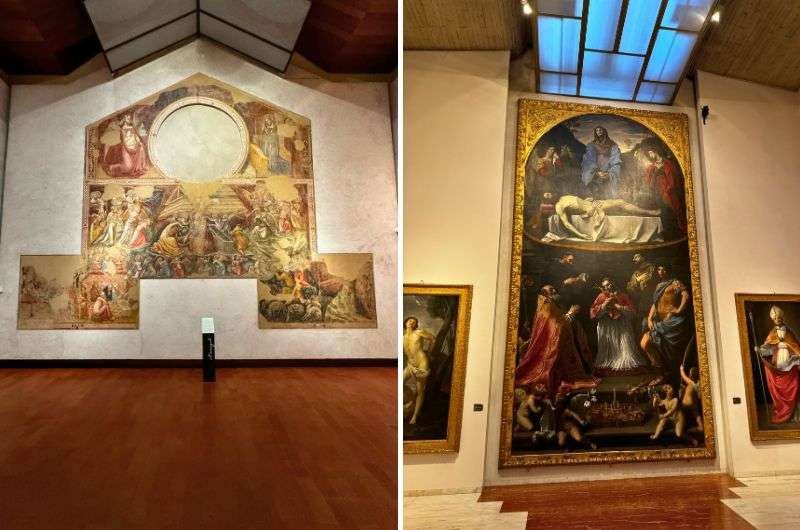
Wander through the National Art Gallery of Bologna
- Distance from last stop: 160 m (175 yd)
- Time spent here: 1.5 hours
- Opening hours: 9 am–7 pm Tuesday–Sunday
- Price: EUR 12
Art lovers, rejoice! The penultimate stop on your itinerary of things to do in Bologna is the Pinacoteca Nazionale, or National Art Gallery. This place is a must for anyone who appreciates the evolution of art, especially during the medieval and Renaissance periods.
Pace yourself—there’s a lot to see
This gallery spans 30 rooms (pace yourself, like we did), and is even lucky enough to house one of the most important collections of Italian art in the country. From breathtaking frescoes to groundbreaking masterpiece paintings, this is both a total feast for the eyes and a crash course in art history—and all for a very reasonable EUR 12.
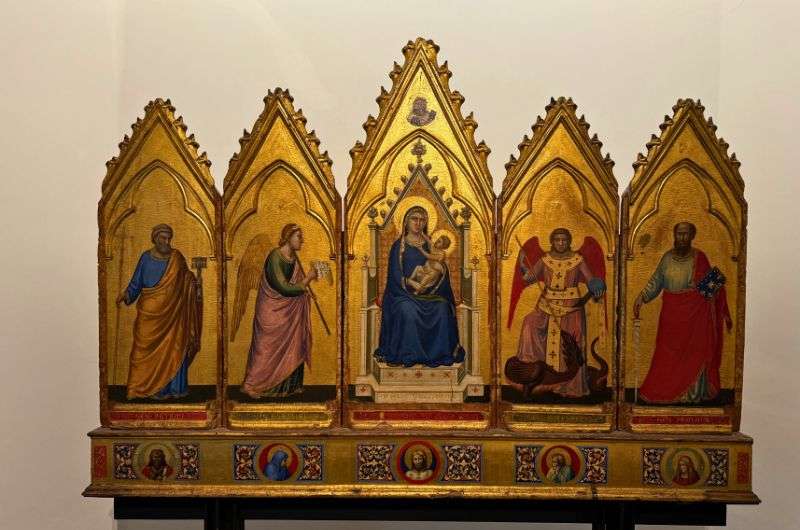
Another example of what to see in National Art Gallery of Bologna
We were taken on a real journey, starting with the Byzantine-inspired works of the Middle Ages and moving into the bright, humanistic beauty of the Renaissance. There were works by Giotto, whose trailblazing use of realism changed the game for Western art; and Guido Reni, a local Baroque superstar whose massive canvases left us in awe.
But the real standout was Lavinia Fontana, one of the first female artists to gain international fame during her lifetime. Seeing her work in person felt like meeting a long-lost Renaissance badass.
Art, or just anti-Catholic vandalism?
One of the gallery’s most unique displays is its collection of frescoes that have been ripped straight off church walls. Entire chunks of painted fresco have been carefully preserved and put on show here, just for the benefit of the viewing public who are too lazy to go to an actual church. It sounds ungodly, but admittedly, I found it fascinating.
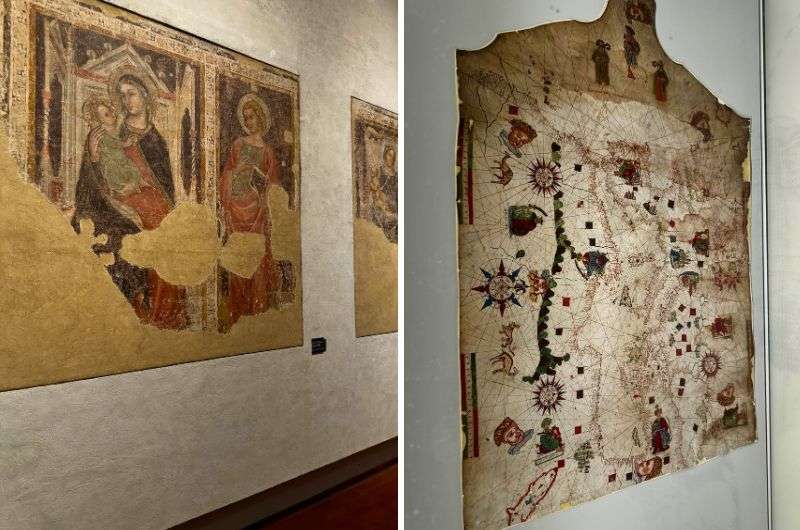
Some of the frescoes have been ripped straight off church walls. Just slightly controversial
Pro tip: Don't be worried about missing out on the details—the gallery provides a user-friendly audio guide via QR code. Most of the key descriptions are also in English, so you won’t have to guess whether that mournful-looking cherub is genuinely upset or, much like me at this point, was just bloated from eating too much pasta.
Plan for about 1–2 hours here, depending on your stamina for art. The gallery isn’t overcrowded, so you can enjoy the works at your own pace.
Stop 9: Basilica di Santo Stefano
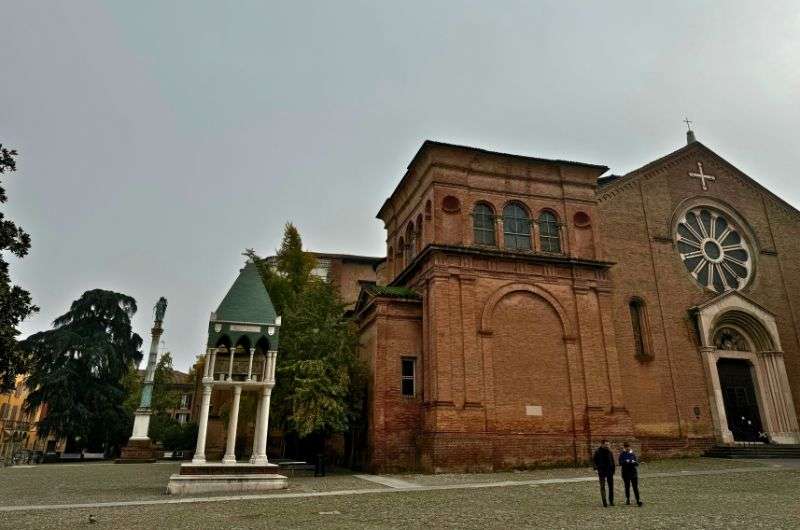
Basilica di Santo Stefano
- Distance from last stop: 1 km (0.6 mi)
- Time spent here: 1 hour
- Opening hours: 7:30 am–12:30 pm and 2:30 pm–7:30 pm Tuesday–Sunday
- Price: free
To wrap up your day in Bologna, make your way to the small but mighty Basilica di Santo Stefano, a fascinating and peaceful complex often referred to as the “Seven Churches” (Sette Chiese). Despite its nickname, only four interconnected churches are left today, but each one is packed with history and atmosphere. (Two of my favorite things, in case you hadn’t gathered by now!)
Fun fact: This ancient site dates back as far as the 8th century, making it one of Bologna’s very oldest landmarks.
It’s easy to get lost—in more ways than one
When I stepped into Santo Stefano, it felt like I was stepping back in time—maybe more so than any of the other Bologna attractions we’d visited so far. This place is more than just a basilica; it’s a medieval maze of chapels, courtyards, cloisters, and crypts. You could hide for days in here if you were running from the law!
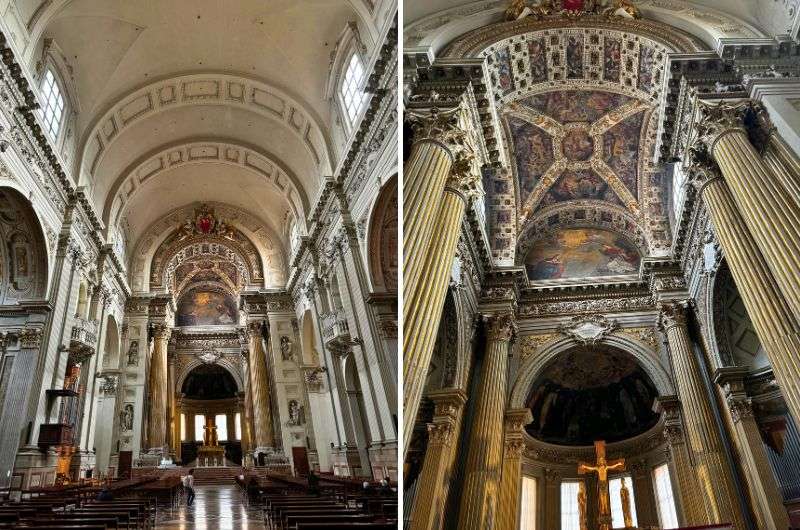
Basilica di Santo Stefano from the inside
There’s no entry fee (but as ever, donate—don’t be cheap). You’re free to wander at your own pace, which made it even easier for me to lose myself in the layers of history. You won’t find much by way of signage or detailed explanations, though, so it’s more of a “look and imagine” experience. Get creative!
Tip: If you’re one of those people who has no imagination whatsoever, a quick online search before your visit will help you appreciate the significance of what you’re seeing at Santo Stefano.
A fitting end to one day in Bologna
Okay, so Santo Stefano doesn’t boast the soaring grandeur of the Basilica di San Petronio or the scale of San Luca, but it definitely has a charm of its own. The worn bricks and dim lighting give it an intimate, even... otherworldly feel. It’s less polished and touristy, more authentic—kind of like Bologna as a whole.
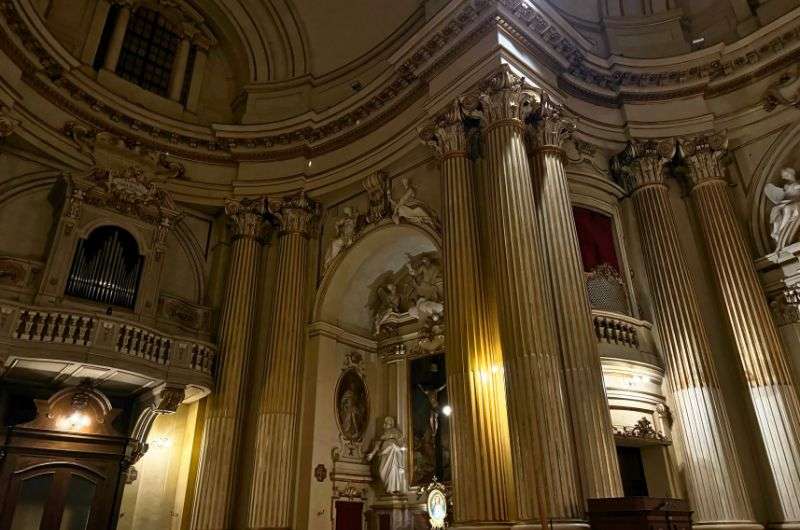
And we’re getting to an end
Each part of the complex has something to boast about. The Church of the Crucifix has an atmospheric crypt, while the Church of the Holy Sepulchre was once believed to house relics of Christ’s tomb.
The Courtyard of Pilate, with its worn stones and peaceful vibe, is a picturesque spot for a quiet moment. Meanwhile, the charming cloister, surrounded by columns, invites you to pause and soak in the serenity. This was the perfect ending to our one day in Bologna that we didn’t know we needed.

BONUS: Take a Bologna food tour!
If there’s one thing that Bologna is boss at, it’s food. Known as La Grassa (“The Fat One”—no political correctness here), Bologna is a total mecca for Italian cuisine, especially where meat and cheese are involved, and a food tour is one of the best ways to experience the city.
While this suggestion isn’t part of this one-day itinerary, it’s worth considering if you’re staying longer—or if you’re willing to swap sightseeing for serious eating. Neither of these conditions applied to us on our visit, but like the goody-goody I am, I read up on Bologna’s food tours anyway.
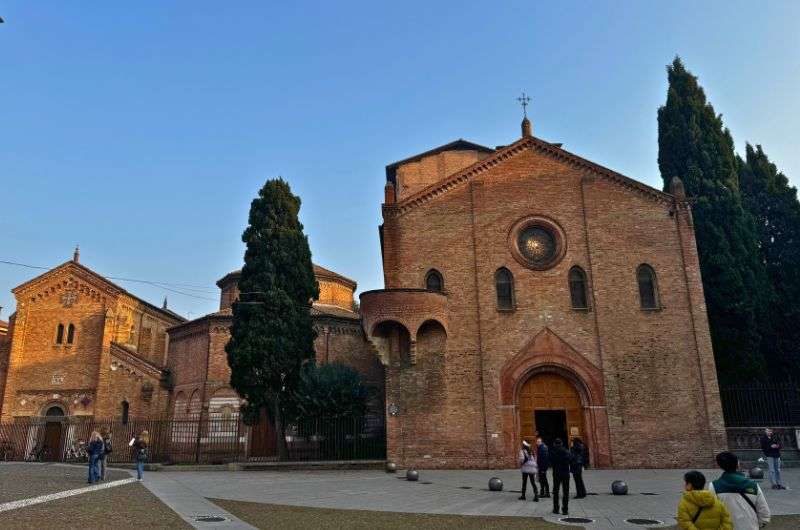
And you’re in Italy so go and try all the amazing food!
How long is a Bologna food walking tour?
Food tours in Bologna usually last 3–4 hours, taking you through the city’s markets, local eateries, and historic food shops. You’ll get to sample Emilia-Romagna’s most iconic delicacies, including ragout, tortellini, and cured meats like mortadella and Parmesan cheese. Some tours even throw in tastings of balsamic vinegar from nearby Modena, and locally produced wines like Lambrusco or Pignoletto.
One highlight of these tours is Bologna’s Quadrilatero district, located just off Piazza Maggiore. This historic market area is packed with deli counters, pasta shops, and bustling cafés, lots of which have been serving locals for centuries! Your guide will walk you through the area’s rich culinary history, pointing out the best places to shop and the best things to try.
Is it the right experience for you?
Who should go on a food tour? Well, a Bologna food tour is perfect for anyone who wants a deeper connection to the city’s culture through its cuisine (read: a proper foodie). They’re also great for solo travelers, as the small group setting makes for a fun opportunity to socialize. Plus, you’ll pick up plenty of tips on things to do in the rest of your time in the region.
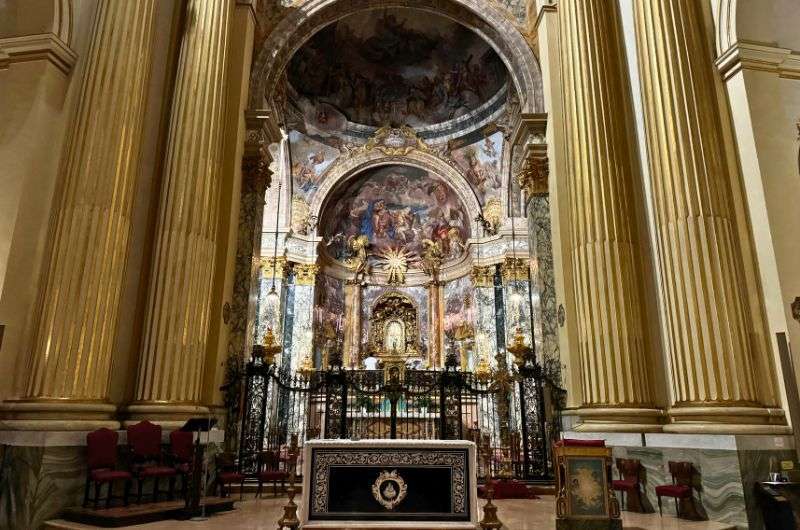
After all the temples and history, you must be hungry
Practical information: Bologna food tours typically cost between EUR 70 and EUR 100 per person, depending on the length and number of stops. Morning tours are the most popular as they let you experience the markets at their busiest, but evening tours with aperitivo options are also available.
You might also be interested in:

Is Bologna worth visiting?
Absolutely, Bologna is worth visiting! It's a foodie’s paradise, home to tagliatelle al ragù and mortadella ham, but it’s also so much more. With the oldest university in the world, UNESCO-listed porticoes, and landmarks like the Leaning Two Towers and Basilica di San Petronio, it’s packed with history and charm.
What is Bologna best known for?
Bologna is probably best known for its food culture, earning it the nickname La Grassa (The Fat One). Traditional Bolognese dishes include meat sauce (ragout), mortadella, and tortellini. Bologna is also famous for its Two Towers, UNESCO-listed porticoes, and being a student city with the world’s oldest university - established in 1088.
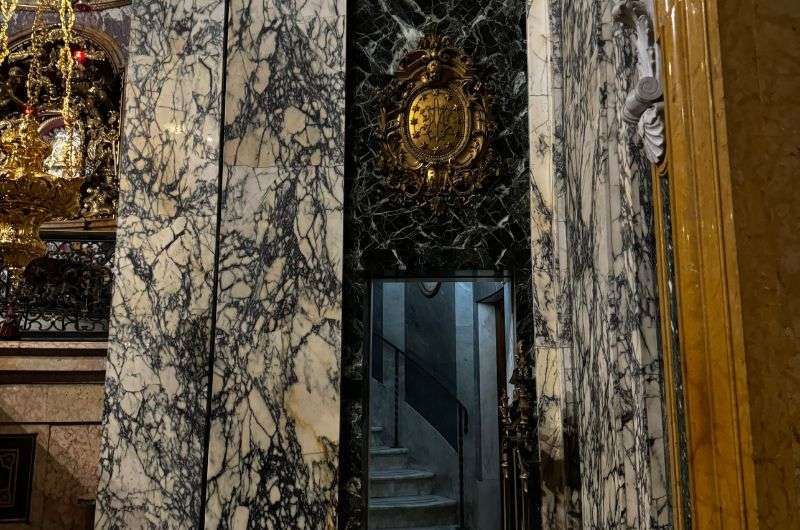
Noble marble in Bologna’s Basilica San Luca
How walkable is Bologna?
Bologna is extremely walkable, with its compact historic center easily explored on foot. The city’s famous porticoes (covered walkways) stretch for miles, providing shelter from the sun and rain, making strolling even more enjoyable. Most major attractions, like Piazza Maggiore, the Two Towers, and the Basilica di San Petronio, are within walking distance of each other. For longer distances, bikes and scooters are widely available for hire.
What is the covered walkway in Bologna, Italy?
The covered walkway in Bologna is the Portico of San Luca, a 3.5-kilometer (2.2-mile)-long arcade with approximately 666 arches. It connects the city center to the Sanctuary of the Madonna di San Luca on Monte della Guardia. Built between 1674 and 1732, it was designed to protect religious processions from the elements. It’s the longest portico in the world and a unique Bolognese experience.
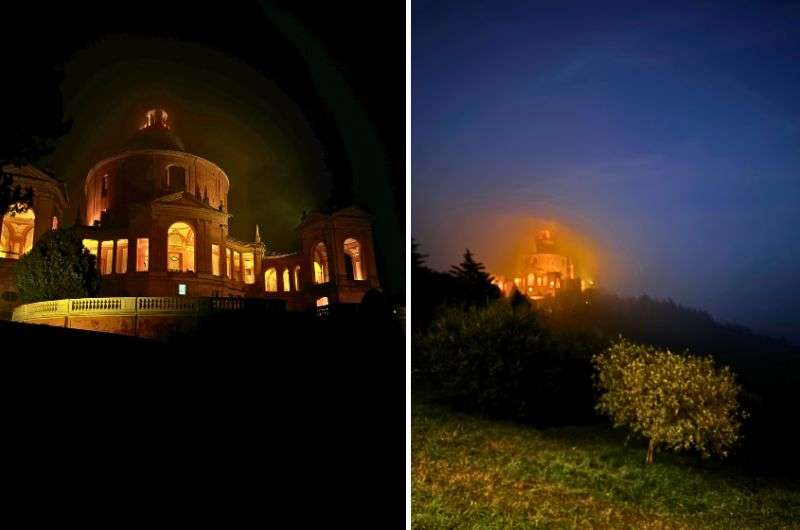
Portico of San Luca
Is Bologna nicer than Florence?
Whether you consider Bologna or Florence a nicer city depends on what you’re looking for. Florence has got Renaissance art, grand museums, and a polished tourist charm, but it’s often crowded and pricey. Bologna, on the other hand, feels more medieval, authentic, and laid-back, with fewer tourists, world-renowned food, and a lively, student-driven energy. It’s less showy than Florence, but it offers an authentic slice of Italian life.
Sometimes, all you need to do is take the first step... I've filtered out the best hotels in Italy for you
Save it for yourself to come back to later, or share with your friends on social media!
I've already planned your ititnerary for the trip, complete with my travel tips.
This post contains affiliate links. I earn a small commission if you make bookings through my links, at no additional cost to you. Thank you for your support!




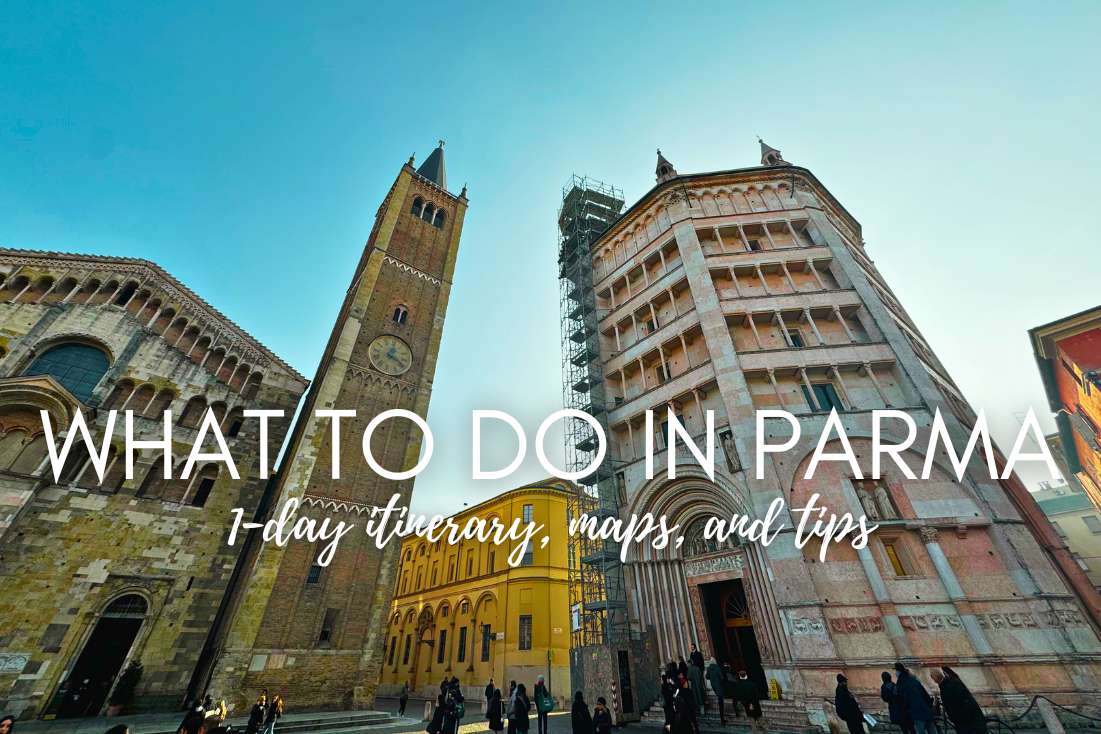
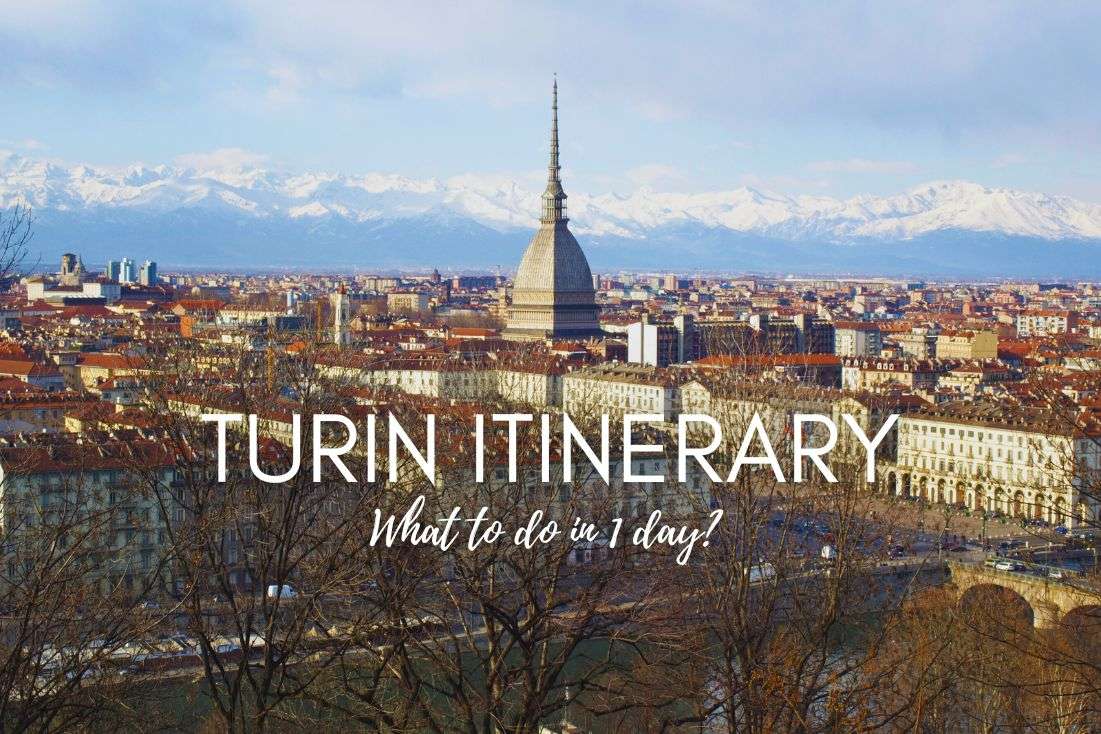




Comments | Thoughts? Give us a shout!